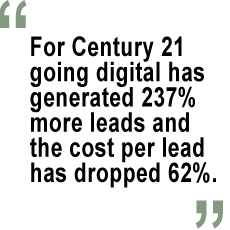Search Strategies Starting To Intersect With Demand Generation Efforts As Budgets Shift To Online
- Published in Feature Articles
The intersection of search engine marketing and demand generation is narrowing substantially as more budgets are shifting offline dollars to online media and also getting more sophisticated about how they convert traffic into opportunities.
Several of the speakers at this week’s Search Engine Strategies Conference & Expo in New York shared success stories on how search optimization efforts, coupled with demand generation strategies, had resulted in a higher volume and improved quality of opportunities for their sales organizations.
Two of the high-profile companies unveiling their results of search optimization included international realtor Century 21 and health and beauty giant Avon. For Century 21 there was nothing subtle or transforming about going digital, Beverly Thorne, Century 21's SVP marketing said that a market survey conducted in early 2008 showed that only 10% of total U.S. homeowners were in the market to buy or sell.

Of those in-market customers, 87% were actively engaged online. With print and TV campaigns largely ineffective, 100% of the company ad budget went from offline to online. The strategies: display ads on portals, paid search, listings on real estate sites, and a new social media effort called C21 Communities.
For both Avon and Century 21, a primary goal of the shift to online was stronger lead generation, For Century 21 going digital has generated 237% more leads and the cost per lead has dropped 62%.
As part of its digital transformation, Avon had to recruit new multichannel representatives to sell the product online and off, brand the product line, and acquire new customer leads. Since the 122 year old brand has more than 5 million representatives, the transformation was hardly an overnight phenomenon.
Avon did not commit to a 100% budget transfer, according to Executive VP Pattiann McAdams-Russell. But over the course of two years the company has moved 78% of its reps from bell ringers to multichannel reps that can sell and fulfill online. 55% of the company's leads now come from portals, search, affiliate marketing, and email. The customers who come to Avon online spend 11% more than offline customers.
A TARGETED APPROACH
As large organizations like Avon and Century 21 continue to refine their online efforts, they are now turning to more sophisticated search strategies like behavioral targeting, which uses cookies to track what sites people visit.
Google announced its entrance into the behavioral targeting game last week, which could help enable a third party logistics provider to focus their search dollars on someone has visited several supply chain information sites.
The latest data from the Search Engine Marketing Professionals Organization (SEMPO) shows behavioral targeting has moved ahead of demographic targeting on the priority list. According to SEMPO’s "The State of Search Engine Marketing 2008" report, advertisers on average would pay 10% more this year for both demographic targeting and daypart targeting; they would pay 13% more for behavioral targeting.
The SEMPO report also showed there is still room for better integration between search optimization and lead nurturing. Two in five advertisers said they are not currently targeting or retargeting searchers but plan to in the next 12 months, while another third (34%) said they are not currently targeting or retargeting searchers and have no plans to do so in the next year. Another 44% said they were targeting searchers either through an ad network, a portal or consumers who had previously visited their site.
North American spending on SEM for 2008 was expected to total over $13.4 billion. Paid placement (buying keywords that will show up as a search result) took 88% of that spending, or $11.9 billion. The report projects that search spending will grow to $26.1 billion by 2011 in North America, tempered by macroeconomic conditions.
The report also predicted an upswing in spending as the economy recovers in 2011. "Constraints on growth today include not only limited advertiser budgets, but also a dip in the volume of search queries as consumers spend less (and thus search less) in categories such as travel, retail and financial services," states the report. "However, as the economy recovers, growth in search is driven by advertiser demand, rising keyword pricing and cost per click efficiencies."

